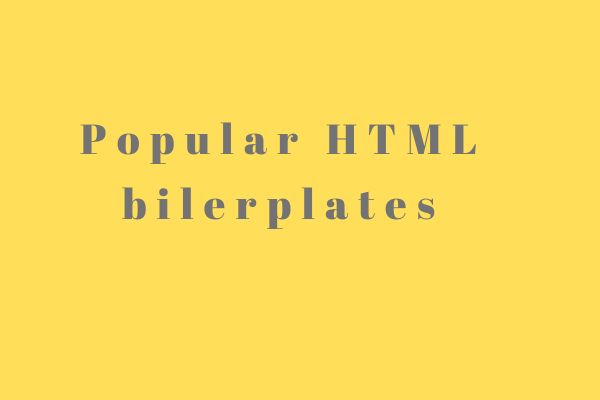Are you a web developer and looking for the best way to start your project? Look no further than the HTML boilerplate.
In this article, we’ll cover everything you need to know about HTML boilerplates. It includes what they are, how they work, and the benefits they offer.
By the end of this guide, you’ll be equipped with all the knowledge you need to start using HTML boilerplates to streamline your web development process.
What Is An HTML Boilerplate?
HTML boilerplate is a starting point for a web development project that includes all the necessary code and structure to get a webpage up and running quickly.
It typically includes basic HTML, CSS, and JavaScript code, as well as a set of recommended practices for web development.
HTML boilerplates are designed to be flexible and customizable. So that developers can easily modify them to fit their specific needs.
Why use an HTML boilerplate?
Using an HTML boilerplate offers several benefits for web developers. Firstly, it saves time by providing a ready-made structure that developers can build upon.
This can be especially helpful for beginners who are still learning the basics of web development. Secondly, HTML boilerplates are designed with best practices in mind, which can help improve the overall quality and performance of a website.
Finally, many popular HTML boilerplates are open source, meaning that developers can use and modify them for free.
Anatomy of an HTML boilerplate
An HTML boilerplate typically includes four main sections: the doctype declaration, the HTML tag, the head section, and the body section.
Doctype declaration
The doctype declaration is the first line of an HTML document and specifies the version of HTML being used. For example, the doctype declaration for HTML5 is:
<!DOCTYPE html>
HTML tag
The HTML tag wraps around the entire document and specifies that the document is written in HTML. It looks like this:
<html>
...
</html>
Head section
The head section of an HTML document contains metadata about the page, such as the title, links to CSS and JavaScript files, and other information that isn’t displayed on the page itself.
Here’s an example of what the head section might look like:
<head>
<title>My Website</title>
<link rel="stylesheet" href="style.css">
<script src="script.js"></script>
</head>
Body section
The body section of an HTML document contains the actual content that will be displayed on the page.
This might include headings, paragraphs, images, and other HTML elements. Here’s an example of what the body section might look like:
<body>
<h1>Welcome to my website!</h1>
<p>This is some example text.</p>
<img src="image.jpg" alt="An example image">
</body>
Popular HTML boilerplates

There are many popular HTML boilerplates available, each with its own set of features and benefits. Here are three of the most popular:
HTML5 Boilerplate
HTML5 Boilerplate is a popular HTML boilerplate that provides a starting point for web development projects. It’s designed to include all the necessary code and structure to get a webpage up and running quickly, while also incorporating best practices for modern web development.
While HTML5 Boilerplate is a great starting point for many web projects, it’s important to note that it’s not a complete solution.
That is, it doesn’t provide all the functionality that a complex web application might require.
For example, if you’re building an e-commerce site or a social media platform, you’ll likely need to add custom code to handle user authentication, data storage, and other advanced features.
That said, HTML5 Boilerplate is highly customizable, which means that you can add your own code to extend its functionality.
It’s also well-documented, which makes it easy to understand and modify even for developers who are new to web development.
One of the strengths of HTML5 Boilerplate is its focus on performance optimization. The boilerplate includes a number of best practices for optimizing website speed and minimizing page load times.
This includes things like the minification of CSS and JavaScript files, using a content delivery network (CDN) for common libraries, and optimizing image sizes.
In addition to its performance optimization features, HTML5 Boilerplate includes a number of other useful features, such as a responsive design, which ensures that websites built with the boilerplate will look good on any device, and a default set of styles and typography, which can be easily customized to fit your specific design preferences.
Bootstrap
Foundation
How to use an HTML boilerplate
Using an HTML boilerplate is simple. First, choose the boilerplate that’s right for your project. Then, download or clone the boilerplate from its website or GitHub repository. Once you have the boilerplate, you can customize it to fit your specific needs.
This might involve adding your own HTML, CSS, and JavaScript code, as well as modifying the existing code to suit your design preferences.
Customizing an HTML boilerplate
Customizing an HTML boilerplate is a matter of adding or modifying code within the existing structure.
For example, you might want to add a new CSS class to style a specific element or add a new JavaScript function to handle user interactions.
Most HTML boilerplates are designed to be flexible and customizable, so you should be able to modify them to fit your needs without too much difficulty.
Best practices for using HTML boilerplates
While HTML boilerplates can be a great time-saver and productivity tool, there are a few best practices to keep in mind when using them.
Firstly, make sure you understand the code that’s included in the boilerplate, so you can modify it effectively. Secondly, don’t rely too heavily on boilerplates to do all the work for you – they’re designed to be a starting point, not a complete solution.
Finally, remember to test your website thoroughly before launching it to ensure that everything works as expected.
HTML Boilerplate Shortcut vs code
To generate an HTML boilerplate in Visual Studio Code using a shortcut, you can use the following steps:
- Open Visual Studio Code (VS Code) on your computer.
- Create a new HTML file or open an existing one.
- Inside the HTML file, you can type
!and then press theTabkey. This is a built-in shortcut in VS Code that expands into a basic HTML boilerplate.
After pressing the Tab key, you will get the following HTML boilerplate code:
<!DOCTYPE html>
<html lang="en">
<head>
<meta charset="UTF-8">
<meta name="viewport" content="width=device-width, initial-scale=1.0">
<title>Document</title>
</head>
<body>
</body>
</html>This boilerplate includes the necessary structure for an HTML file, including the <!DOCTYPE> declaration, the <html>, <head>, and <body> tags, as well as some essential meta tags. You can then start adding your content within the <body> tag.
Using this shortcut can save you time and help you quickly set up a basic HTML file in Visual Studio Code.
Conclusion
In conclusion, HTML boilerplates are a valuable tool for web developers that can save time and improve the quality of their websites. By understanding the anatomy of an HTML boilerplate, choosing the right one for your project, and customizing it to fit your specific needs, you can streamline your web development process and create high-quality websites more efficiently.




